It’s tough to live without electricity in today’s world, even when you’re traveling in a diy van conversion. And if you want to keep your laptop charged, or if you like to make super healthy smoothies for breakfast, or if you prefer to freshly grind your coffee every morning – you need a power inverter.
An inverter is a device that converts DC electrical current (the 12V power coming from your van’s batteries) to AC current (the type of electricity that comes out of a standard wall outlet). With the help of a good inverter, you can still power all of your appliances from your van’s 12V electrical system.
So how do you go about choosing an inverter? Wading through all the options out there can be insanely confusing and raises a ton of questions for the uninitiated.
There are so many different ones – how do I know which is the best power inverter for me? Why is this one so much more expensive than that one? There are a lot of weird, random brands on Amazon – which ones actually make quality products? What size inverter should I get, and will it power what I need?
In this post, we aim to answer all of these questions and more. We’ll also provide you with some recommended inverters, as well as some tips for safely installing one in your van. So read on, and you’ll be powering your AC devices on the road in no time!
This post is adapted from our ebook Vanlife Solar Basics.
Are you tired of jumping from website to website trying to wrap your head around your van’s electrical system? Our comprehensive guide covers everything from fundamentals to components to sizing to installation, all in one easy-to-follow package.
Introduction to Off Grid Power Inverters
A power inverter is a device that converts direct current (DC) from a battery bank in an off-grid solar power system into alternating current (AC) for powering AC appliances.
Many of the electronic appliances in a camper van can be powered by your main 12V DC system, including your 12 Volt refrigerator, ventilation fan, LED lights, and devices like phones and tablets. But you need an inverter to power anything that plugs into a standard wall outlet, like blenders, induction cooktops, microwaves, battery chargers, coffee grinders, or power tools.
Power inverters are designed to take a specific voltage input, meaning that if you have a 12V battery bank, you need a 12V inverter. If you’re installing a small solar system in a camper van or RV, you will most likely be dealing with 12V. If you are installing a bigger system in a tiny home or off grid dwelling, you may be dealing with 24V or even 48V, in which case you need an inverter designed for that voltage input.
But here we’re looking at the best inverters for van life, so from here on out we’re sticking with inverters the convert 12V DC current to 120V AC.
Modified Sine Wave vs Pure Sine Wave Inverters
All inverters convert DC electricity to AC, but not all inverters are created equal. There are two types of inverters out there, and each produces a different quality of electrical output.
Modified sine wave inverters are the cheapest and simplest. They produce a stepped, blocky waveform that only approximates the smooth waveform of pure AC power. Because of this, they can cause performance issues, overheating, or even damage with sensitive electronics, medical equipment, or anything with an inductive load (such as refrigerators, motors, variable speed power tools, and induction cooktops). Modified sine inverters are also much less efficient, which can be an issue in an off grid situation when every Ah of battery matters.
Pure sine wave inverters produce a smooth waveform that is functionally equivalent to the grid power that comes out of the wall in a stationary dwelling. Because of this, they are perfectly fine for powering anything you might want to power, including sensitive electronics, medical equipment, and inductive loads. Pure sine inverters are highly efficient, often greater than 90%, meaning you can squeeze more out of your batteries and solar panels. However, they are more expensive than modified sine inverters.
Bottom Line: We recommend going with a pure sine wave inverter, especially if you’ll be using it full time. These output cleaner current, are more efficient, and are better for powering sensitive modern electronics.
Read More: Pure Sine Wave vs Modified Sine Wave Inverters
Do You Need an Inverter/Charger?
Inverter/chargers function as both a power inverter and battery charger if/when you plug your van into shore power. If you often stay at campgrounds or friends’ driveways, having an inverter/charger allows you to plug in and charge your batteries while you’re stationary. This adds a ton of flexibility as a backup power source, and allows you to supplement your solar.
Inverter/charges also typically have a built in transfer switch, which allows you to power your AC appliances directly from shore power while you’re plugged in and switches over to the battery/inverter setup when you’re not.
Inverter/chargers are more expensive than standalone inverters, but it’s worth the extra cost if you have a large electrical system and often stay places with shore power hookups. If you’re running a lot of AC devices, the automatic transfer switch feature is convenient and reduces wear and tear on your batteries. Inverter/chargers are typically only available in larger sizes (2000W+).
Another option for plugging into shore power is to get a standalone battery charger and use it alongside a pure sine wave inverter. Because you’re adding another component this kind of setup is a bit more complicated to install, but it allows you to buy an inverter first and add on shore power as needed, and it can sometimes be cheaper.
Bottom Line: Inverter/chargers are a necessity for bus conversions, RVs and camper vans with larger electrical systems because they give you the added flexibility of an additional charge source. However, if you mostly boondock in the wilderness and rarely stay at campgrounds, you can save money going with a standalone inverter.
What Size Inverter Do You Need?
Power inverters are sized by the Watts of AC power they can generate. You’ll want to pick an inverter with enough wattage output to power your AC devices, while making sure it does not exceed what your batteries can handle.
Inverters have ratings for both Continuous Watts and Peak/Surge Watts.
Continuous Watts refers to the amount of current the power inverter can output on a continuous basis. This is usually the listed size of the inverter (i.e. a 1000W inverter can output give or take 1000 continuous Watts). Make sure to choose an inverter that’s rated to handle the continuous wattage of all the AC electronics you’ll be running at once.
Peak or Surge Watts refers to the maximum Wattage a power inverter can generate for a short period. For example, you might have a blender that pulls 300 Watts continuously, but on startup it may have a 600W surge for a few seconds. If you’re running electronics that have a startup surge, make sure you pick an inverter with a high enough surge rating.
Calculating Your AC Power Needs
To calculate what size inverter you need, first add up the wattage rating of all the AC electronics you think you’ll be using at the same time. That’s the total amount of Watts you need (don’t forget to look for surge wattage if you have appliances with a startup surge).
Where do you find this info?
All AC electronics should have a wattage rating listed in the tech specs. (If you don’t have those available, it’s usually pretty easy to find them online. Just Google “your appliance + manual” or “your appliance + technical specifications.”)
Here’s an example of AC power draws in a camper van:
| Device | Wattage |
|---|---|
| Laptop | 130W |
| Immersion blender | 200W |
| Coffee grinder | 150W |
| Battery charger | 90W |
| Total | 570W |
The total energy consumption in this example is 570 Watts. You might not necessarily run all of these appliances at the same time, so you can adjust this list on based on what you’ll be powering simultaneously.
For this base example, you need a minimum 700W inverter, but it’s a good idea to size up so that your inverter isn’t working too hard. We recommend going with a 1000W inverter here to give yourself some extra flexibility.
Keep in mind that sizing your inverter based on your AC power consumption will get you a minimum size. The maximum size is based on the size of your battery bank, which we’ll get into below.
Going with an inverter that’s sized up for your battery bank will allow you the flexibility to power things you didn’t expect and to expand your system in the future without replacing your inverter. However, we don’t recommend running an inverter larger than 3000W on a 12V system, because the high potential amperage draw of larger 12V inverters make them difficult to install safely.
Bottom Line: Calculate the total wattage of the AC devices you plan to power simultaneously to get the minimum size inverter you need. It’s a good idea to size up based on what your battery bank can accommodate, but don’t go larger than 3000W on a 12V electrical system.
For most vanlifers, a 1000W-1500W inverter will cover basic power needs, but if your battery bank is big enough, 2000W or larger inverters allow for more flexibility.
How Much Battery Capacity Do You Need to Run an Inverter?
When you’re designing your van’s electrical system, it’s vital to make sure your battery bank is large enough to power your inverter.
Luckily, there is a simple rule of thumb to help figure this out:
For every 1000W of inverter wattage, you need a minimum of 100Ah of usable battery capacity.
The usable capacity of a battery bank depends on the type of battery. Lithium iron phosphate batteries (LiFePO4 or LFP) can be 100% discharged, so a 100Ah LFP battery has 100Ah of usable capacity. However, AGM batteries and other lead-acid batteries can only be 50% discharged, so a 100Ah AGM battery has a usable capacity of 50Ah.
Even though this rule of thumb is easy for quick planning, you should go through the actual battery and inverter sizing calculations below as you’re designing your system.
To calculate the battery capacity needed to run an inverter, you need to know
- the max continuous discharge current of your batteries, and
- the total Amp draw of your inverter.
To find the max continuous discharge current of your batteries, check the specifications for the specific batteries you are using. In general, a 100Ah LiFePO4 battery will have a max continuous discharge of 100A. If you have two 100Ah batteries wired in parallel, the max continuous discharge is 200A (again, check the specs for your actual batteries).
To calculate your inverter’s amp draw we need to account for inverter inefficiency. Remember that most pure sine wave inverters are about 90% efficient. So to calculate the total Amp draw we need to take the inverter’s total wattage and divide it by 0.90, then divide that by the system voltage.
Here’s an example using a 1200W inverter:
1200W / 0.90 = 1333W / 12V = 111A
The 111A draw of a 1200W inverter is too high for a 100Ah battery to handle. In this example, we would need to either step up to a higher battery capacity to get a larger discharge current OR downsize our inverter.
If you are sizing your inverter for your battery bank, then based on the rule of thumb above you can add up to 1000W of inverter for every 100Ah of battery capacity.
Read More: Epic Guide to Your DIY Camper Van Electrical System
What to Look for When Choosing a 12V Inverter for Van Life
Wading through product listings and power inverter reviews online can get confusing, and reviewers on places like Amazon have varying experience/knowledge levels about complex electronics like inverters.
Here are the specs to look at when choosing your inverter.
- Voltage compatibility. Inverters are designed to work with specific DC voltage inputs. If you have a 12V battery system, make sure you’re buying a 12V inverter.
- Continuous Watt rating. This is what the inverter is capable of continuously outputting.
- Peak/Surge Watt rating. This is what the inverter is capable of outputting for short periods, or “surges.”
- Efficiency rating. This is the overall efficiency of the inverter. For example, an inverter that is 90% efficient will consume 10% more wattage than the device it’s powering.
- No load/idle consumption. This is how much amperage the inverter consumes when it is not powering a load.
- Automatic shut off safety features. At the very least, your inverter should automatically shut down if it detects too high/low voltage from your battery, if there is an AC input overload, and if the inverter begins to overheat.
- AC output options. Some inverters have terminal for hardwiring your AC electronics, while others only have three prong outlets for plugging in extension cords. If you plan on distributing your AC power to outlets throughout your van, look for an inverter that includes an AC terminal block.
Also make sure to look for UL listing, ETL certification, or other safety compliance rating by an independent testing board.
To make sure you’re getting a power inverter that’s safe, we highly recommend getting one that conforms to UL Standard 458 for mobile power inverters/converters. This is a US-Based safety standard that means the inverter has been independently tested to make sure it follows electrical safety best practices for vehicle installations.
Testing can be done by UL themselves (UL Listed), or by a variety of Nationally Recognized Independent Labs. The most common NRIL certifications that you’ll see on inverters are UL, ETL, MET, and CSA. If you’re in the EU or Australia and your inverter is does not carry one of these certifications, it should conform to the safety standards of your locale. The point is, find an inverter that has been independently tested and certified for safety.
There are a lot of cheap inverters out there that don’t have any kind of safety certification. While you may be able to save a bit of money going this route, we don’t recommend playing with safety when it comes to electronics – especially at higher voltages like 120V.
Where to find all of this info?
Product manuals are a great place to hunt down technical specifications that you might not be able to find elsewhere, and they can give you an insight into the care and detail that the manufacturer puts into their products.
They also normally list any independent safety certifications that the product holds, which will ensure that you’re getting an inverter that conforms to the highest safety standards.
Where to find the manual? Check the manufacturer’s website, or just Google “inverter model + manual.”
Recommended 12V Power Inverters for Vanlife
Below we list our recommended pure sine inverters for vanlife, including important specs and power inverter reviews. We did the research to help you make a decision on the best power inverter for your van.
All of the inverters we recommend below meet the following criteria:
- Manufactured by a reputable brand
- Include high/low voltage, AC input overload, and high temperature shutdown protections
- Certified to conform to UL Standard 458 for mobile power inverters/converters
Xantrex ProWatt SW Pure Sine Wave Inverters
Xantrex ProWatt SW pure sine wave inverters are solid pieces of equipment. We have the ProWatt 1000 in our van, and it’s worked flawlessly for us. Xantrex has been around for decades, and their products have a very high reputation in the RV industry. These highly efficient power inverters do what you need them to do, and they do it quietly and with a minimum draw on your batteries.
We can also attest that Xantrex has good customer support. We once torqued off the ground screw on our inverter when we were rearranging our electrical area. We called Xantrex, and they had a warranty replacement in the mail the next day. Super easy.
Xantrex ProWatt inverters handle continuous loads remarkably well, but their surge ratings are lower than many other inverters on the market. The label wattage is also something of a misnomer – for example, the ProWatt 1000 is only rated for 900 continuous Watts. But these are sturdy, reliable, and efficient inverters that should serve you well on your travels.
These inverters are pricier than many inverters you’ll find online, but they’re actually a pretty good value among high end inverters.
Xantrex ProWatt Inverters are available in the following sizes:
- 600W | 1000W | 2000W
- Remote Switch
AIMS Power Pure Sine Wave Inverters
AIMS Power has only been around since 2001, but they are quickly becoming a respectable force in the mobile energy arena with a full line of products from power inverters to charge controllers. Despite some early initial quality issues, AIMS pure sine wave inverters are some of the best on the market today. Not only that, they’re a hell of a value, and are probably the best bang for your buck among all the inverters we looked at.
One thing to be aware of – although most of their products are ETL certified, not all of them are (for instance, their 1500W inverter is conspicuously not ETL Listed). Be on the lookout for “ETL Listed” in the product title – AIMS has non-ETL compliant versions of many of their inverters. While you can save a few bucks going this route, we highly recommend staying with safety-certified inverters for your van.
AIMS inverters are highly efficient with good surge output, and are quickly gaining a reputation for quality and value. If you just can’t justify shelling out for a Xantrex, take a look at AIMS inverters for your van build.
AIMS Power pure sine wave inverters are available in the following sizes:
- 1000W | 1500W (Not ETL Certified) | 2000W
- Remote Switch
AIMS Power Pure Sine Wave Inverter/Chargers
If you want the ability to charge your batteries from shore power, you’ll need an inverter/charger. And AIMS pure sine wave inverter/chargers are the best of the pack, featuring the quality, efficiency, and overall value typical of AIMS products. AIMS inverter/chargers also include a built in automatic transfer switch, so you can run your outlets off shore power while your batteries charge.
AIMS Pure Sine Inverter/Chargers are available in the following sizes:
Samlex PST Pure Sine Wave Inverters
Samlex is another legendary inverter manufacturer that has been around for decades. They have a very good reputation in the industry, and you probably won’t go wrong choosing one of their inverters.
With their PST line of pure sine inverters, Samlex offers a full range of sizes, from a compact 120W all the up to 200W and beyond. No matter how small or large your power needs are, Samlex has something that fits.
Samlex inverters are on the pricier side, but you tend to get what you pay for when it comes to complex electronics. The smaller models have non-standard Anderson Powerpole connectors, so be prepared for that when planning your electrical system.
Samlex PST Pure Sine Inverters are available in the following sizes:
- 120W | 300W | 600W | 1000W | 1500W | 2000W
- Remote Switch for 600W-1000W
- Remote Switch for 1500W-2000W
Go! Power Industrial Pure Sine Wave Inverters
Go! Power is another manufacturer of high end inverters that are well known for their quality, reliability, and efficiency. These industrial pure sine inverters have a power saving mode that makes their idle draw particularly low. Like Samlex, these inverters are on the pricier end.
Go! Power Industrial Pure Sine Inverters are available in the following sizes:
Krieger Modified Sine Wave Inverters
Krieger modified sine wave inverters are a great value. They are affordable, reliable, and have rave reviews. All Krieger inverters come with a kit that includes wiring, fuses, and a remote switch. However, we think the included wiring is too thin, so we advise sizing up.
Krieger inverter kits are available in the following sizes:
Samlex SAM Modified Sine Wave Inverters
The same great Samlex quality, reliability, and efficiency – this time with a modified sine wave. And Samlex SAM inverters come in a variety of sizes – so no matter your power needs, Samlex has an inverter that will meet them.
Samlex SAM modified sine inverters are available in the following sizes:
Watch Out for Inverters that are NOT Safety Certified
There are several commonly used brands of inverters out there that have NOT been certified for compliance with UL Safety Standard 458 for power inverters/converters. These inverter brands are:
These inverters are widely used in DIY campervans and RV’s, and are less expensive than our recommended picks. One of these units may work perfectly fine for you – but they have not been independently tested for safety, so we can’t recommend them.
Installing Your Inverter in Your DIY Campervan
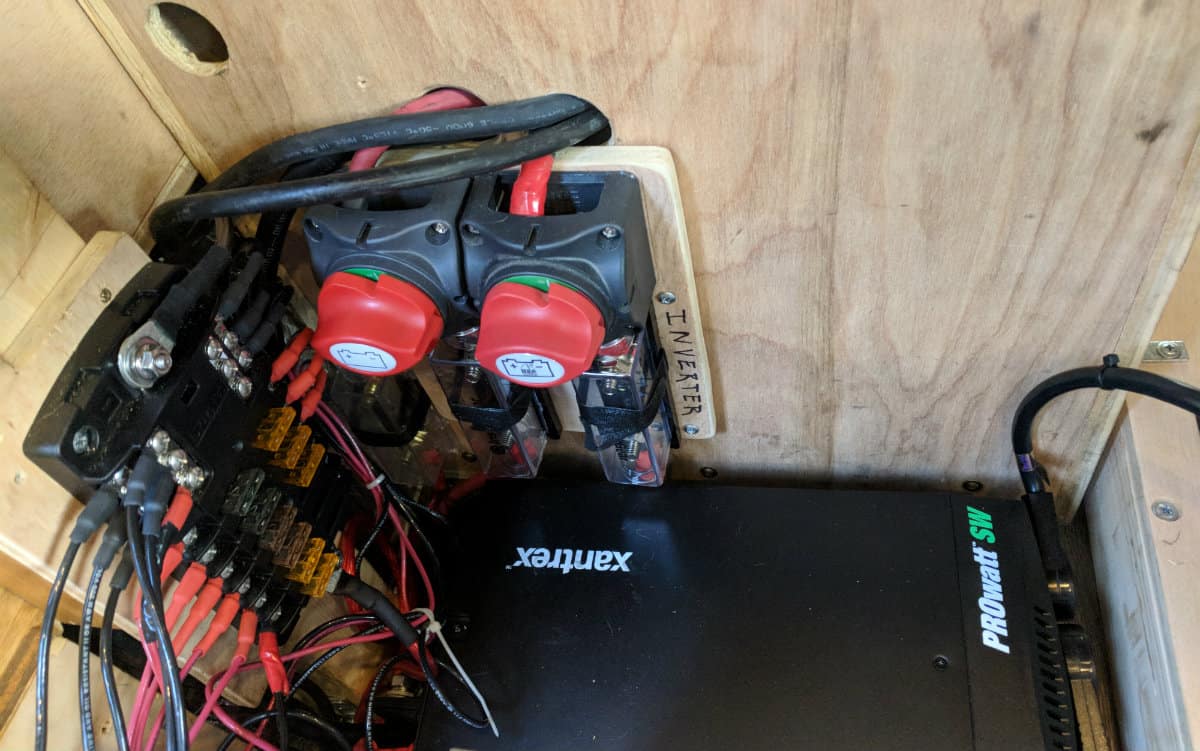
Once you’ve picked your inverter, the next step is installing it in your van. Here are a few things to think about before you get started:
Where your inverter will be located. You want to install your inverter as close to your batteries as possible to minimize the DC wire run. But, you should not place your inverter in the same compartment as lead-acid batteries or other flammable materials.
Give your inverter room to breathe. Inverters need ventilation to prevent overheating. Follow your inverter’s instructions and allow enough space around it for airflow.
Make sure you have the right size cables and fuses. The cable you use to connect your inverter to your battery should be thick enough to handle the current – the thicker the better. The positive cable should also be fused to protect your system in case of a surge.
Check out our camper van electrical system guide for more information on properly sizing cables and fuses.
Include a cutoff switch between the battery and the inverter. This is a safety feature to allow you to cut the electrical feed from the battery if you need to work on the system.
Make sure your inverter is properly grounded to the vehicle chassis. Your inverter’s ground cable should have a solid connection to the van’s chassis to ensure the GFCI outlets function properly and to reduce the risk of shock.
Design your system so the inverter is easy to turn on and off. Either place your inverter so it’s easy to access the power switch, or install a remote switch within arm’s reach. Turning your inverter off when you’re not actively using it will help you consume less power.
Here’s a wiring diagram showing how your inverter should be connected to your batteries:
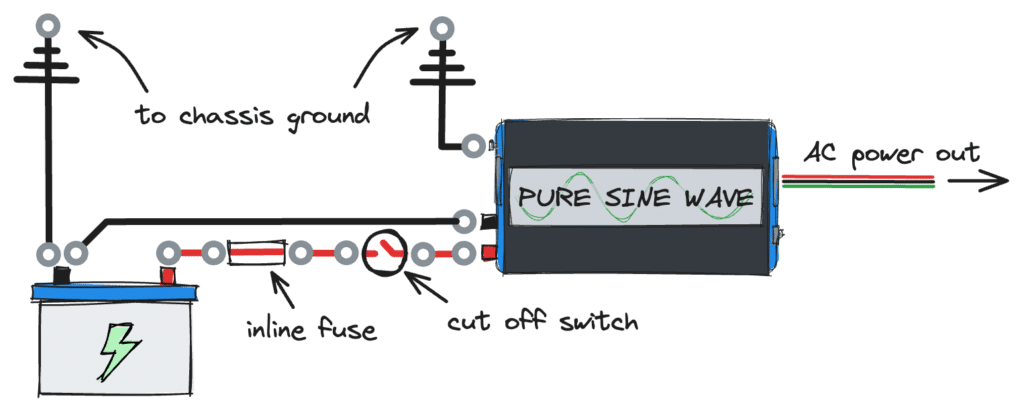
However, if you plan on integrating your inverter into a larger solar electrical system, you will be dealing with other essential components like bus bars, and you’ll need two fuses – a main battery fuse and a dedicated inverter fuse.
Below is a wiring diagram of a 400W solar energy system, including an inverter/charger:
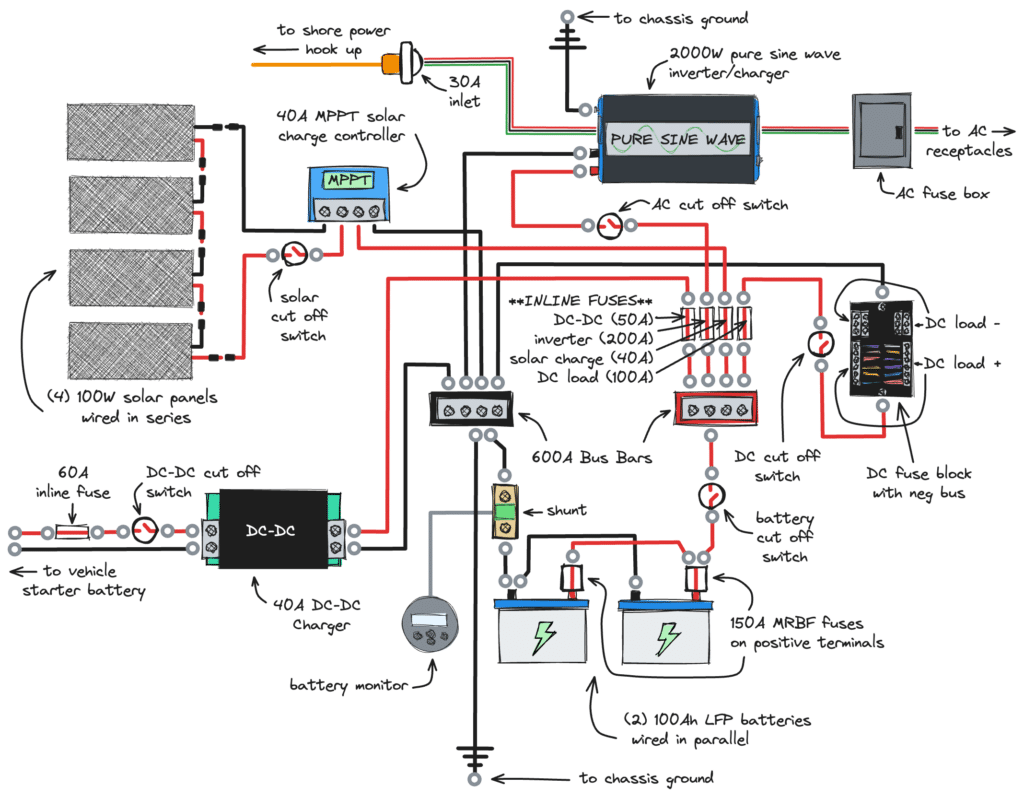
For more detailed information on installing your RV inverter, check out out epic guide to campervan electrical systems.
For an even more detailed walkthrough of installing a power setup in your rig, check out comprehensive ebook Vanlife Solar Basics.


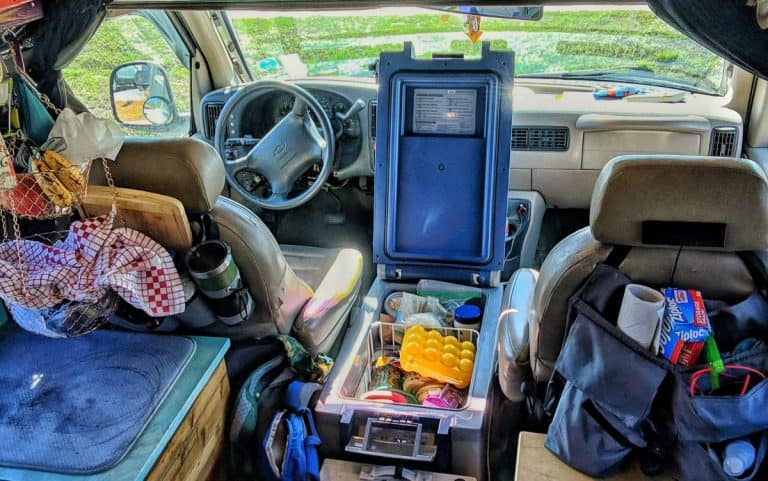
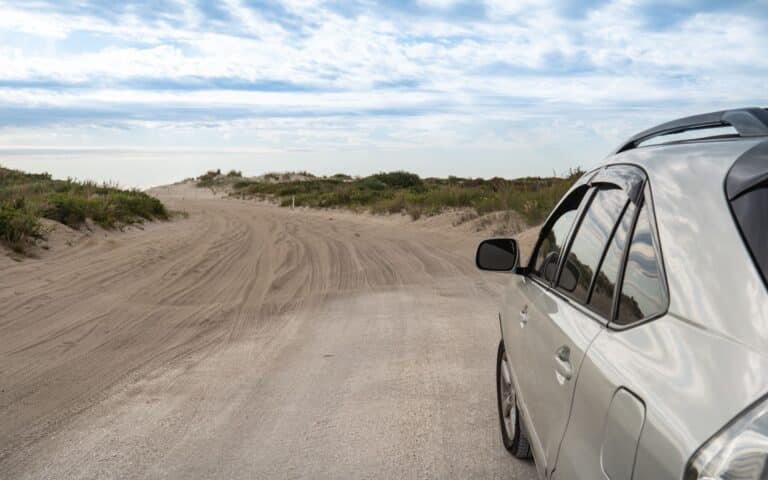
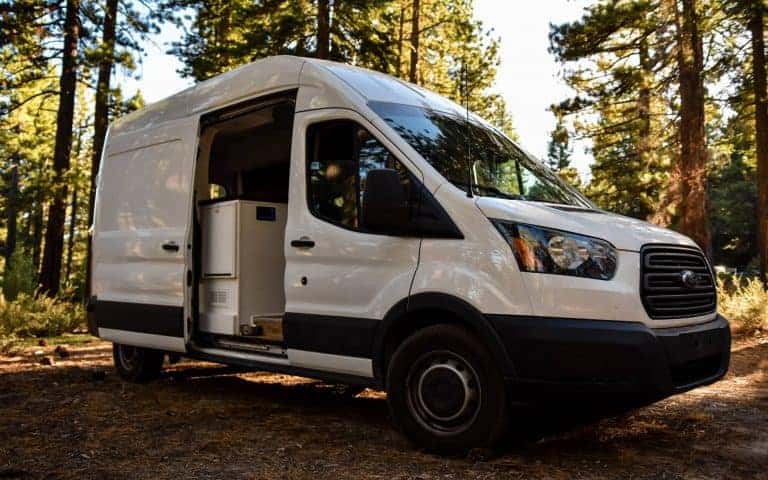
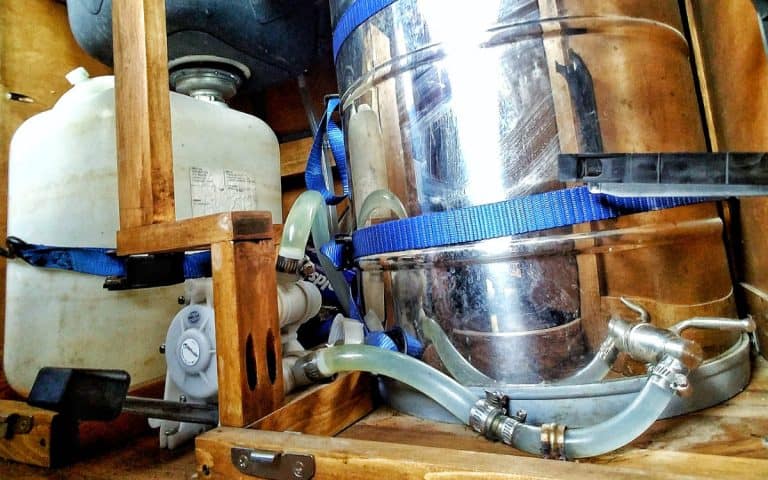

Hi, I understand the logic behind inverters, but I don’t see anyone commenting on boiling a simple kettle, I purchased a 4000 watt inverter ( pure sine) and it wouldn’t pull the skin off a rice pudding, that’s all I’m really after, is it just me or what?
I would of thought a 4000watt system, would of boiled a kettle . I have 2 fully charged 140amp leisure batteries (new) , looking to hear your comments.
Regards Ant.
Hi Ant, what’s the wattage of your kettle? A 4000 watt inverter should run anything that’s less than 4000W.
The Best?? To bad you can only utilize 1 plug at a time on almost all inverters so whats point having 4 sockets( as in picture of this site)
I’m not sure what you’re talking about here. Inverter output is based on wattage, not number of plugs in use.
Good day John I have 2.6kw icecream machine and I want to run it on 12v agm battery pack for 10 hours how many what inverter do i need and how much Batery power do i need. Thanks in advance.
Hi Petros, if your ice cream machine is drawing 2.6kw the whole time, that would be a pretty tall order. You would need a 3000W inverter, first off. But the big barrier is your battery bank size. 2.6kw = 217 amps used per hours (and that’s not even factoring in the efficiency loss with an inverter). So, if you’re going with an AGM battery you would need approximately 450Ah just to run the machine for one hour (since you can’t draw AGM batteries down lower than 50%). If your ice cream machine draws less than 2.6kw on average, then that… Read more »
I find it beneficial reading reviews on electronic items. Because I can learn from other’s mistakes. So, this inverter review is very useful to me.
Glad it was helpful!
Oh this article truly peaked my interest! surely choosing an inverter can be daunting, but the useful tips found on this article will surely help me a lot. Thanks a lot for sharing such a great information with us John Serbell and have a good day.
Glad this was helpful!
Very good article, Its really wonderful post, Thanks for sharing with us.
Thanks Sandy, so glad you enjoyed this post!
Hi John, I appreciate the article and have more to think about. I would recommend that anyone who’s going to charge a laptop or other DC device just get a, “12v to their device” converter. They’ll skip the DC-AC-DC power loss. Just sayin …
Hi Joe, that’s great advice! If all you’re doing is charging a laptop, there are DC laptop chargers available for many devices (laptop chargers already convert the AC from wall outlets to DC for computer charging, so as you mention this avoids that power loss), as well as cheapie inverters that plug into a 12V outlet that work just fine for low wattage applications. We’ll consider adding a section to this post about these kinds of options. Thanks again!
~John
I’m currently building out my van and solar setup, I’m a handyman and I’m looking to have a beefier system in case I need to run any power tools. I have 800 watts of solar going to two 170 AH lithium batteries, in this particular case would you recommend a 3000 watt inverter and if so what do you think I should consider when selecting one?
Hi Zachary, you’ll want to take a look at the wattage of the tools that you plan on using, especially the surge wattage. Any inverter you get should have a surge rating high enough to handle what your power tools will draw. If you plan on using tools one at a time, then you can make your decision based on the tool that has the highest surge wattage. If you plan on using multiple tools at once, then you’ll need to calculate based on the tools you think you’ll be using at the same time. Also, make sure you use… Read more »
Hello!! my girlfriend and i are making the jump in June to be living in our van full time. I feel like i’m misunderstanding the use of the inverter. our original plan was to run an outlet from the fuse box to use most larger kitchen appliances (fridge , possibly an air frier, and water boiler). Should we be plugging those directly into the inverter or will the outlet be enough? Great website! We have used it for a good portion of our van designs and ideas.
Hi Joey, thanks for reading! The purpose of an inverter is to convert the 12V DC electrical current stored in your batteries to 110V AC current (the type that comes out of a standard wall outlet). Any devices you plan on running that have a two or three-prong wall plugs must be run from the inverter, because these devices run on 110V AC current. A fuse box wired to your battery will only work for devices that run on 12V DC current (i.e. LED lights, roof vent fan, 12V appliances, and anything the uses a cigarette-lighter plug). Hope that helps!… Read more »
Thank you for sharing this great content. I’ve a question sir, I have a 3000 watt pure sine wave inverter. And right now I have 2 centennial agm CB12-260 batteries. I will be charging with both solar and wind. But my question is, i need to run at most 1500 watts none stop 24/7 I am thinking I need more batteries, these cost a bundle lol but if I need more? How many more and what do you recommend adding to this bank?
Hi Bryan, thanks for reaching out! To best answer your question, I recommend digging into your power needs in a bit more detail. What appliances are you running, and for how long will you be running them inn a 24 hour period? For example, let’s say you have a 1000W coffee maker, and you use it for 15 minutes per day to make coffee. First, convert watts to amps by dividing by the system voltage (1000W / 12V = 84 Amps). If you ran the coffeemaker for an entire hour, you would draw 84 ah from your batteries. But since… Read more »
Thank you for your beautiful reply.
Very useful and informative post. Thanks for helpful information.
Thanks Disha, glad you enjoyed the article!
This is a great resource! My wife and I full-time out of our truck camper and have lived thus far with a 600W. However we had issues with charging 2 MacBooks at the same time. We learned that your math is a little off from above… the charger says 60W but that is output… the input (what the charger consumes from the inverter) is 1.5A x 100-240V. P=IV. At minimum, 150W to max 360W. So we found with our 600W inverter we were stressing it out when our chargers could draw variable 150-360 each. (We’re not professional electricians either… but… Read more »
Hi Chris, thanks for the correction, I’ll look into that further and update the post. We haven’t had any issues charging both of our computers at the same time (one with the 60W charger and one with the 85W charger). We don’t typically run many devices simultaneously, but we’ve had both of our computers and our rechargeable battery charger plugged in at the same time without issue. The other things we use the inverter for (immersion blender, coffee grinder, etc.) aren’t usually running at the same time as our computers. We have two 155-Ah AGM batteries (310 Ah total) wired… Read more »
Another incredibly useful post as always! I’m building out my electrical system over the next 2-3 weeks and this (plus your amazing full electrical rundown) have been so helpful. Big thank you from SLC, UT!
So glad we can be of help! Best of luck on your build!
~John